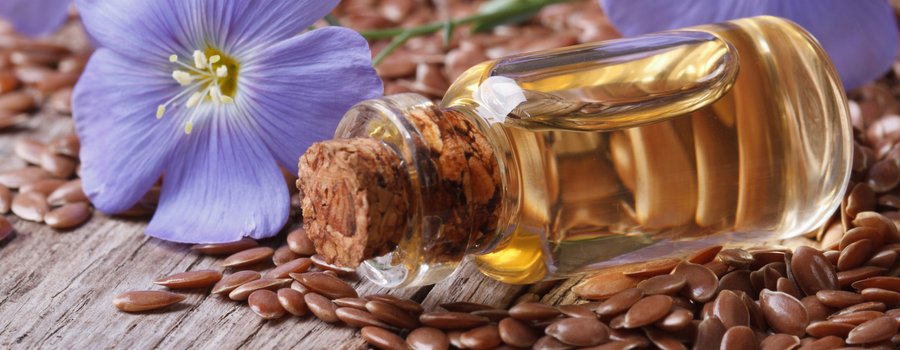
Have you ever seen a flax field? Hard to believe that from these long stems with delicate blue flowers at their ends, derive a wide variety of products such as a golden oil and a very durable fiber which has been used as textile for millennia! Linseed oil, also known as Flaxseed oil, was first used for nutrition. It is much later in its history that several other uses were discovered for it.
Extracted from the ripe seeds of the plant, linseed oil has been used for a few hundred of years for the protection and maintenance of interior and exterior wood. It is without a doubt one of the most popular finishing oil in the world.
Its wide availability and many properties have made it a component of choice for certain paints and an excellent binder for oil paintings. Replaced by synthetic alkyd resins for several decades, linseed oil is coming back in force lately, thanks to its non-toxicity and its environmentally friendly characteristics.
Protection, maintenance and aesthetics

Easy to use, affordable and usually environmentally friendly (depending on the chosen brand and added components), linseed oil is certainly a finishing product one has to try for the first time or to rediscover. Impregnating the wood to saturation, linseed oil provides a golden hue, which will turn to amber over time. This property is sought after by many, but avoided by some. It's a matter of taste.
The natural beauty of the grain on different wood species is nowadays more and more popular with consumers and linseed oil proves to be a very good choice to showcase it. It deeply nourishes wood while providing a flexible protection that is waterproof, abrasion resistant and which will also resist to liquids such as alcohol, coffee and juice.
Raw, polymerized, with or without drying additives: How to choose?
The oldest among us who have only used raw linseed oil still believe that all linseed oils take an extremely long time to dry, and make wood surfaces rather sticky. Indeed, raw linseed oil has a drying time of about three days or more for each coat, which doesn't make it very popular... Generally, this oil will be diluted with the same quantity of citrus solvent or odorless thinner.

The best kind of linseed oil (and the most popular kind too!) is double boiled or polymerized linseed oil. This oil has gone through a vacuum cooking process at very high temperatures, which increases its viscosity and shortens its drying time significantly, compared to traditional raw linseed oil. Double boiled or polymerized linseed oil is also used in oil based paints and varnishes. One interesting aspect of this process is that it provides a pure oil that can be used to finish food contact surfaces.
Some manufacturers also add siccative agents (drying additives, usually cobalt or manganese), which further reduce the drying time. One can also add his own drying agents to linseed oil, as long as instructions are carefully followed.
Key features of linseed oil
- Non-film forming (as opposed to varnishes)
- Waterproof, elastic and wear-resistant finish
- Satin finish
- Slight smell of grass
- Deep penetration
- Golden to amber
- Affordable and ecological
- Easy to use
- Easy care
- Drying between 12 and 24 hours if polymerized and/or drying agents are used.
- Enhances the beauty of the grain
- Dried by evaporation and oxidation
- Compatible with most oils
Where, when, and how to use

Linseed oil is most often used indoors, either on paneling, moldings, beams, furniture and even on floors, which in this last case requires maintenance twice a year given the high stress of the surface .
It is important to apply this finishing oil only on bare or previously oiled wood, since any other finish such as paint, varnish or wax will prevent the penetration of the oil.
Painted, varnished or waxed wood will therefore need to be cleaned and/or stripped to bare wood before proceeding with linseed oil application. The surface must be sanded and dusted to ensure good penetration. Typically, three coats at 12 to 24 hour intervals are sufficient. When the last coat is completely dry, a light hand polishing can be done: This will enhance the satin finish and smooth the texture.
Once it's done, plan for maintenance once a year or as needed (twice a year on floors). Superficial scratches can be easily repaired with a small application of oil locally.
Several trendy materials may be coated with linseed oil, even though some are extremely absorbent. It is the case for cork, terracotta, stone, and concrete countertops. Again, three coats are usually more than sufficient.

Before proceeding with oil finishing, be aware that one can stain the wood first with water, alcohol or hybrid stains. An alternative is to add earth pigments or iron oxides in the first coat of oil, which will provide a slight coloring. Walnut stain is also an excellent natural color to get a nice variety of light brown to dark.
For outdoor use, don't forget to treat the wood with protection against insects and fungi first. It is also necessary to color the wood in order to prevent the graying caused by UV rays. Linseed oil can also be used to make your own very durable homemade paint that can be used outside.
The ease and simplicity of finishing with linseed oil are such that someone with no experience in this area also will get a result as satisfying as an experienced craftsman would get. Here's how:
Materials required
- Double boiled linseed oil
- 120 grit sandpaper
- Cotton rags
- Stain Pad, paintbrush (optional)
- Nitrile gloves
- 000000 steel wool or 800 grit sandpaper
Steps to finish with linseed oil
- Sand the surface of bare wood with 120 grit sanding paper to ensure good oil penetration.
Dust the surface. - For better penetration, mix the first coat with a mild solvent such as citrus solvent or odorless thinner. (Tried and True oils require no dilution).
- Apply the first coat with a brush, roller or cloth.
- 10 to 15 minutes after application, completely wipe the surface to remove any excess oil. Failure to complete this step will leave you with a sticky surface.
- 2-3 coats, applied at 12 to 24 hours intervals are necessary for proper protection. Make sure you follow the directions specific to the product you're using.
- For an ultra soft touch finish, proceed with a light sanding with a 600 or 800 grit sandpaper, or a 000000 fine steel wool, at least 24 hours after the last coat has been applied. You're done!
- Maintenance will have to be done about once a year or according to the wear of the finish. Dry looking or discolored wood is a good indicator that you need to reapply a light coat of oil. Simply clean the surface with a damp cloth, let dry completely and apply the oil, wiping all excess oil after 5 minutes at most.
That's the secret to a beautiful satin finish which, given proper care, will always retain its original appearance.
Getting rid of oil soaked rags
Whether you want to refresh a 60's dresser, give a little love to Grandma's sideboard or protect and maintain your new wall paneling, no need to call in expert hands: you now have the tools to succeed in your next finishing project with linseed oil.








